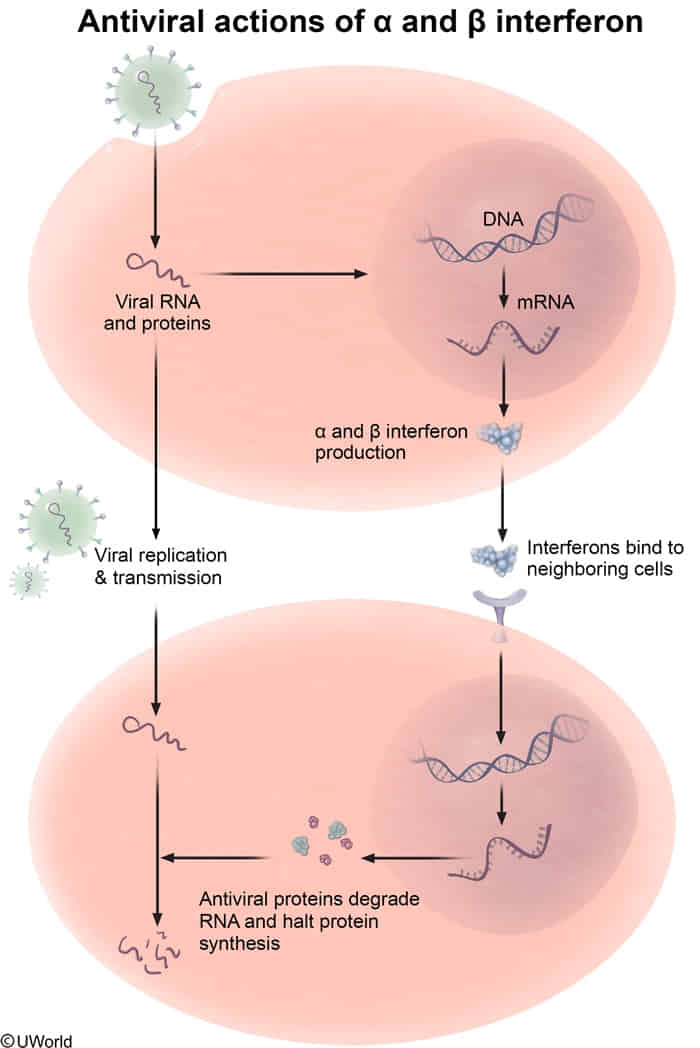Tip
- IFN-α & IFN-β (Type I)
- Function: Induce an antiviral state in neighboring cells; ↑ MHC I.
- IFN-γ (Type II)
- Source: Th1 & NK cells.
- Function: Activates macrophages & NK cells; ↑ MHC I & II; promotes Th1 differentiation; helps form granulomas.
- TNF-α
- Source: Macrophages.
- Function: Mediates septic shock & cachexia; causes fever; maintains granulomas.
- TNF-β (Lymphotoxin-alpha)
- Source: Lymphocytes.
- Function: Similar to TNF-α; supports lymphoid organogenesis.
Overview of Interferons
Type I Interferons

Interferon Alpha (IFN-α)
- Mainly Secreted By:
- Virus-infected cells and malignant cells
- Fibroblasts (interferon-β)
- Function:
- Acts as the first line of defense against all viral infections
- Inhibits viral protein synthesis by activating ribonuclease L, leading to the degradation of cellular and viral mRNA
- Promotes the expression of MHC class I molecules, aiding in the recognition of virus-infected cells and activation of NK cells and cytotoxic T cells
- Inhibits megakaryocyte stem cell differentiation and proliferation
- Therapeutic Use:
- Chronic hepatitis B
- Acute and chronic hepatitis C
- Kaposi sarcoma
- Adjuvant therapy for malignant melanoma
- Renal cell carcinoma
- Condyloma acuminatum
- Hairy cell leukemia
- Essential thrombocythemia
- Side Effects:
- Flu-like symptoms (fever, chills)
- Depression
- Myopathy
- Neutropenia
- Interferon-induced autoimmunity
- Gastrointestinal issues (nausea, vomiting, diarrhea)
- Itchy skin
Interferon Beta (IFN-β)
- Therapeutic Use:
Type II Interferons
Interferon Gamma (IFN-γ)
- Mainly Secreted By:
- Th1 and NK cells (when stimulated by IL-12 from macrophages or antigen contact)
- Function:
- Activates macrophages to increase phagocytosis (positive reinforcement) and NK cells to eliminate virus-infected target cells
- Synergistic effect with tumor necrosis factor in stimulating macrophages to form granulomas, crucial against mycobacterial infections
- Suppresses a Th2 response (negative feedback)
- Promotes the expression of MHC class II molecules and antigen presentation in every cell
- Stimulates antigen class switching to IgG3
- Therapeutic Use:
- Chronic granulomatous diseases (e.g., leprosy, leishmaniasis, toxoplasmosis)
Tumor Necrosis Factor Superfamily
- Pro-inflammatory cytokines secreted by leukocytes in response to inflammation and/or infection
- Their signaling pathways regulate inflammation, apoptosis, and cellular proliferation and differentiation
- There are over 20 tumor necrosis factors, with cachectin and lymphotoxin-alpha being the most important
Cachectin (Tumor Necrosis Factor, formerly TNF-α)
Secreted by:
- Activated macrophages
Functions:
- Pyrogenic
- Cytotoxic and inhibits carcinogenesis of certain tumors
- Mediates septic shock by activating the endothelium, leading to:
- Vascular leakage
- Recruitment of white blood cells
- Causes malignant cachexia
- Its role in cachexia is explained by its influence on the hypothalamus, leading to appetite suppression. It also increases basal metabolic rate.
- Maintains granulomas, which are critical for defense against mycobacterial infections
Therapeutic Significance:
- TNF inhibitors like infliximab are used to treat refractory chronic inflammatory systemic diseases (e.g., Crohn disease)
Lymphotoxin-alpha (formerly TNF-β)
Secreted by:
- Activated lymphocytes
Functions:
- Cytotoxic, leading to inhibition of carcinogenesis
- Promotes colony stimulating factor synthesis, which leads to:
- Fibroblast proliferation
- Stimulation of wound healing
Therapeutic Significance:
- TNF inhibitor etanercept can bind lymphotoxin-alpha